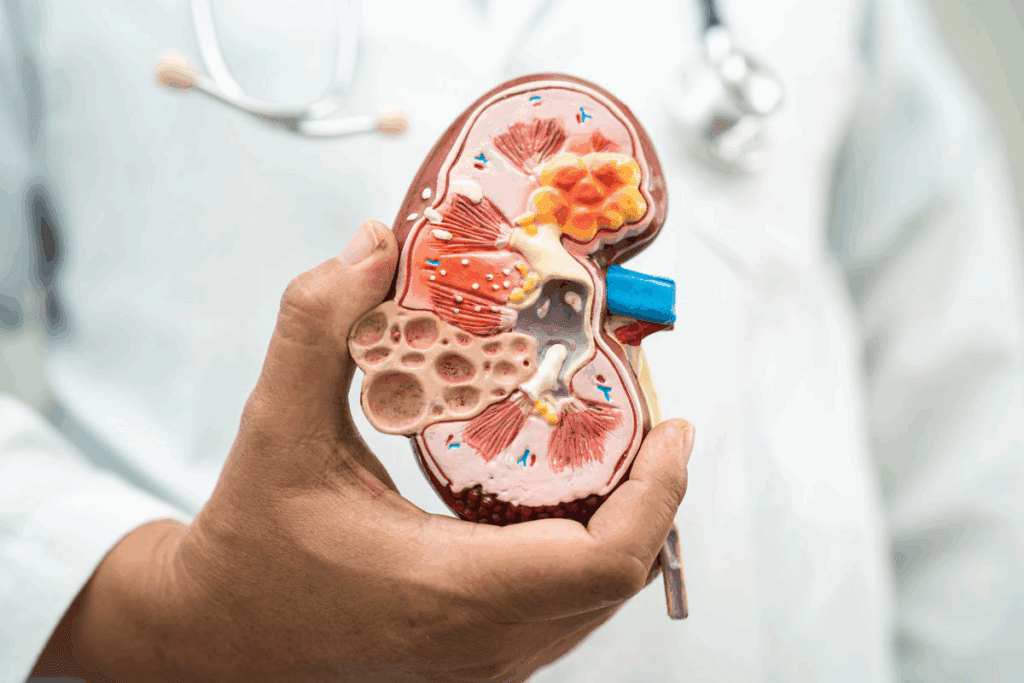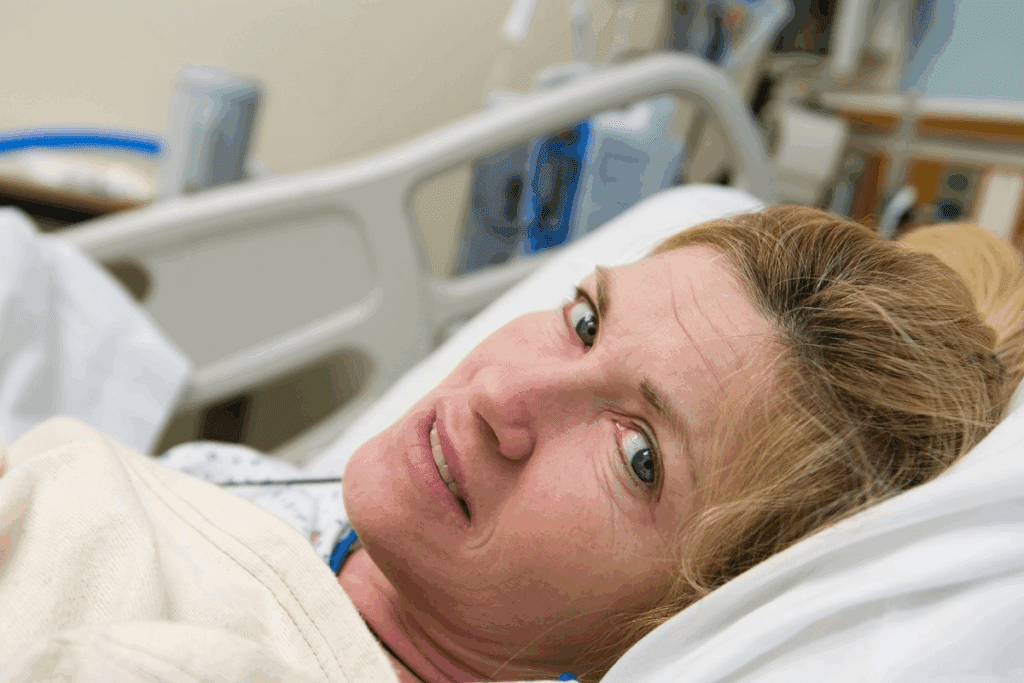Last Updated on November 20, 2025 by Ugurkan Demir

When kids get kidney cancer, they often have Wilms tumor, or nephroblastoma. Anaplastic Wilms Tumor is a special kind. It’s very aggressive and hard to treat.
Anaplastic Wilms Tumor makes up about 10% of Wilms tumor cases. It’s tough because it doesn’t respond well to usual treatments. At places like Liv Hospital, a team of experts gives each child the best care they can.

It’s key to know about Wilms tumor for early spotting and handling of this kidney cancer in kids. Known also as nephroblastoma, it’s the top kidney cancer in children.
Wilms tumor is a kidney cancer mainly found in kids. It often shows up as a big belly mass without symptoms. Kids with unilateral cases are usually 44 months old, and those with bilateral cases are 31 months old.
It can affect one or both kidneys. Its occurrence rate varies among different groups of people.
About 9.7 cases per million children under 15 have Wilms tumor. This shows why we need to be aware and catch it early.
Studying Wilms tumor’s spread is vital. It’s the most common kidney tumor in babies and young kids. Girls are slightly more likely to get it than boys.
| Age Group | Incidence Rate (per million) |
| 0-4 years | 12.1 |
| 5-9 years | 8.5 |
| 10-14 years | 2.3 |
Knowing how Wilms tumor spreads helps us find risk factors and better treatments. Scientists are always looking into what causes it.

Anaplastic Wilms Tumor is a serious kidney cancer in kids. It’s known for its aggressive nature and unfavorable histology. We’ll dive into what makes it so complex.
Anaplastic Wilms Tumor is a rare and aggressive form of Wilms tumor. It’s marked by anaplasia, which means its cells grow and divide abnormally. About 10% of Wilms tumors are anaplastic.
Experts say anaplasia is key in figuring out how serious the tumor is. Anaplastic tumors have big, abnormal cells and lots of cell division. This is a sign of anaplasia.
The look of Wilms tumor cells is very important. Tumors with unfavorable histology, like anaplasia, are harder to treat. This helps doctors decide how to treat the tumor and if it might come back.
The terms nephroblastoma and Wilms tumor mean the same thing. It’s a kidney cancer that mostly affects kids. Knowing the terms helps doctors diagnose and treat it right.
As we learn more about Anaplastic Wilms Tumor, we see it’s a tough condition to tackle. By understanding its definition, classification, and cell structure, we can improve treatment options.
The study of Wilms tumor shows big differences in different groups. This kidney cancer mainly hits kids. Knowing how it spreads helps find it early and treat it better.
Wilms tumor is the top kidney cancer in kids, making up 90% of cases. It happens to about 8 kids per million under 15 each year. It’s more common in African and African American kids than in East Asian kids.
Some genetic syndromes raise the risk of Wilms tumor. For example, WAGR syndrome and Beckwith-Wiedemann syndrome increase the risk. These syndromes have genetic changes that make kids more likely to get Wilms tumor.
Wilms tumor mostly hits kids under 7, with most cases in 3 to 4-year-olds. Girls are slightly more likely to get it than boys in some places.
Many genetic syndromes raise the risk of Wilms tumor. These include:
These syndromes have specific genetic changes that lead to Wilms tumor. Knowing about these links helps with early detection and genetic advice.
| Genetic Syndrome | Key Features | Risk of Wilms Tumor |
| WAGR syndrome | Wilms tumor, Aniridia, Genitourinary anomalies, mental Retardation | High |
| Beckwith-Wiedemann syndrome | Overgrowth, Macroglossia, Omphalocele, increased risk of childhood tumors | Moderate to High |
| Denys-Drash syndrome | Early onset nephrotic syndrome, Genital abnormalities, Increased risk of Wilms tumor | High |
Understanding Anaplastic Wilms Tumor’s pathological features is key for doctors to plan effective treatments. This tumor is known for its unique microscopic traits. These include diffuse or focal anaplasia, which affect its diagnosis and outlook.
Anaplastic Wilms Tumor shows anaplasia, a sign of its aggressive nature. Anaplasia means cells look abnormal, showing the tumor’s aggressive growth.
Anaplastic Wilms Tumor can have either diffuse or focal anaplasia. Diffuse anaplasia means anaplastic cells are everywhere in the tumor. Focal anaplasia is found in specific spots. Knowing this helps doctors predict the tumor’s behavior and treatment.
Markers and classification systems are vital for diagnosing Anaplastic Wilms Tumor. They help doctors tell it apart from other Wilms Tumors. This is important for understanding the tumor’s behavior and how it will grow.
| Pathological Feature | Description | Prognostic Implication |
| Anaplasia | Presence of cells with abnormal morphology | Indicates aggressive tumor behavior |
| Diffuse Anaplasia | Widespread presence of anaplastic cells | Poor prognosis |
| Focal Anaplasia | Limited presence of anaplastic cells | Relatively better prognosis |
“The accurate diagnosis of Anaplastic Wilms Tumor relies heavily on the identification of its distinct pathological features, including the presence and extent of anaplasia.”
Recent studies have uncovered the molecular mechanisms behind Anaplastic Wilms Tumor. The disease’s genetics are complex, with many alterations contributing to its aggressive nature.
Genetic changes are key in Wilms Tumor’s development and growth. Mutations in the WT1 gene and others are critical. “The WT1 gene is a tumor suppressor that’s vital for kidney and gonad development,” research shows.
WT1 mutations are linked to some Wilms Tumors. They can affect how the tumor behaves and responds to treatment.
The expression of WT-1, Pax-2, and Pax-8 genes is important in understanding Anaplastic Wilms Tumor. These genes are involved in kidney development and are often disrupted in Wilms Tumor.
N-myc expression is linked to treatment resistance in some Anaplastic Wilms Tumors. Tumors with N-myc expression are more aggressive and have poorer outcomes.
“N-myc amplification makes tumors resistant to chemotherapy in cancers like Wilms Tumor,” research notes. This highlights the need for targeted treatments that overcome this resistance.
Wilms tumor symptoms can vary, making it hard to diagnose. It often shows up as an abdominal mass without any pain. But, it can also cause abdominal pain and blood in the urine.
The main symptom is an abdominal mass found by caregivers. Other signs include:
These signs suggest Wilms tumor. A detailed check is needed to confirm it.
Wilms tumor can also show systemic signs. These include:
These symptoms can also appear in other conditions. So, it’s key to think of Wilms tumor when diagnosing.
Other abdominal masses and conditions can mimic Wilms tumor. These include:
Imaging and tissue tests are vital for the right diagnosis.
Diagnosing Wilms Tumor involves several steps. These include imaging, biopsy, and molecular testing. Accurate diagnosis is key to choosing the right treatment.
Imaging is a big part of diagnosing Wilms Tumor. Ultrasound, CT scans, and MRI are used to see the tumor’s size and where it is. They also check if it has spread.
Ultrasound is often the first choice because it’s non-invasive. It gives clear images right away. CT scans and MRI give more detailed views, helping to understand the tumor better.
A biopsy is key to confirming Wilms Tumor. It helps find out the tumor’s type. This is important for knowing how serious it is.
Looking at the biopsy closely helps decide if the tumor is easy to treat or not. This guides the treatment plan.
Molecular and genetic tests give insights into the tumor’s genes. They look for specific mutations, like in the WT1 gene. This helps predict how the tumor might react to treatment.
These tests also find genetic syndromes that raise the risk of Wilms Tumor.
Staging Wilms Tumor is very important. It helps figure out how far the disease has spread. This information is used to plan treatment.
The staging system classifies the tumor based on its size and spread. This helps choose the best treatment and predict how well the patient will do.
Accurate staging and risk stratification are key for Wilms tumor treatment. The staging depends on the tumor’s size, lymph node involvement, and metastasis.
The Children’s Oncology Group (COG) and the International Society of Pediatric Oncology (SIOP) use a common staging system. It divides tumors into five stages, from Stage I to Stage V.
Stage I: The tumor is in the kidney and fully removed. The kidney’s outer layer is intact, and there’s no tumor spillage.
Stage II: The tumor goes beyond the kidney but is fully removed. It might have touched nearby tissues.
The tumor’s histology is also important. Tumors are labeled as favorable or unfavorable based on anaplasia presence. Recent studies show molecular traits are key in risk classification.
The tumor’s stage and histology greatly affect prognosis. Patients with lower-stage tumors and favorable histology have better outcomes. Those with higher-stage tumors or unfavorable histology face tougher challenges.
Understanding the implications of different stages is vital. It helps tailor treatments to each patient’s needs. We must consider both stage and histology in treatment planning.
Understanding how to treat Anaplastic Wilms Tumor is key. It needs a mix of treatments to fight this aggressive cancer well.
Surgery is very important in treating Anaplastic Wilms Tumor. Nephrectomy is often used to remove the tumor and affected tissues.
How much of the tumor is removed and the stage of the cancer are important. They help decide the treatment plan.
Chemotherapy is a big part of treating Anaplastic Wilms Tumor. Different treatments are used based on the cancer’s stage and type. Multi-agent chemotherapy is used to fight the tumor’s aggressiveness.
The treatment plan is made for each patient. It depends on their risk and how they react to treatment.
Radiation therapy is used for advanced-stage disease or when surgery doesn’t remove all the tumor. External beam radiation therapy is most commonly used.
The radiation dose and area are carefully planned. This helps control the tumor while protecting healthy tissues.
New and targeted therapies are being explored for Anaplastic Wilms Tumor. These treatments target specific cancer growth pathways.
There’s a move towards personalized medicine. Research is ongoing to find biomarkers for these therapies. This aims to improve treatment results.
Bilateral Wilms tumor is rare, affecting a small number of cases. It brings unique challenges for doctors. They must carefully plan treatment to save kidney function.
Bilateral Wilms tumor is rare, showing similar traits to the single-sided version but with more complexity. It’s more common in kids with certain genetic syndromes. Knowing the genetic background is key to treating it well.
Dealing with bilateral Wilms tumor is tough. Doctors must treat the cancer while keeping the kidneys healthy. They use a team effort, including surgery, chemo, and sometimes radiation, tailored for each patient.
Nephron-sparing surgery is vital for treating bilateral Wilms tumor. It tries to remove tumors while keeping as much kidney tissue as possible. Doctors consider the tumor’s size, location, and how it responds to chemo before surgery.
Keeping kidneys healthy is key in treating bilateral Wilms tumor. Doctors use partial nephrectomy, tumor enucleation, and other methods to save kidney function. Chemo helps shrink tumors, making surgery easier.
Improvements in surgery and chemo have helped patients with bilateral Wilms tumor. Doctors keep updating their methods, using the latest research and trials to improve care.
It’s important to keep an eye on patients with Anaplastic Wilms Tumor for a long time. This helps catch and handle any problems that might come up. We’re always working to make treatments better and deal with their long-term effects.
Treatment for Anaplastic Wilms Tumor can cause problems like kidney issues, heart problems, and new cancers. Knowing about these risks helps us give better care.
A study in the Journal of Clinical Oncology showed how common long-term problems are in Wilms Tumor survivors. Here’s a quick look at the findings:
| Complication | Prevalence |
| Renal Dysfunction | 25% |
| Cardiac Issues | 15% |
| Secondary Malignancies | 10% |
Keeping an eye on patients over time is key to catching problems early. Regular checks help us act fast and get better results.
An oncologist said, “Long-term care is more than just watching for cancer to come back. It’s about handling treatment side effects and making life better for survivors.”
“The goal of long-term follow-up is to spot and handle complications early, cutting down on suffering and boosting survival chances.”
Survivors of Anaplastic Wilms Tumor face a big risk of getting new cancers. Regular checks and monitoring are key to catching them early.
Checking how well the kidneys are working is a big part of long-term care. Patients treated for Anaplastic Wilms Tumor need regular kidney checks to catch any problems early.
By knowing about possible complications and using good long-term care plans, we can make life better for Anaplastic Wilms Tumor survivors.
Research on Wilms tumor, like Anaplastic Wilms Tumor, is making big strides. We’re learning more about its molecular biology and genetics. This knowledge is helping us find better ways to treat Anaplastic Wilms Tumor.
Thanks to this research, patients are getting better results. The future looks bright for Anaplastic Wilms Tumor treatment. Scientists are working hard to find new ways to fight the disease and make current treatments even better.
The path forward for Anaplastic Wilms Tumor treatment is all about more research and teamwork. We need to keep pushing the boundaries of what we know. By doing so, we can bring new, personalized treatments to patients. This will be key in improving care for those with Wilms tumor.
Anaplastic Wilms Tumor is a rare and aggressive form of Wilms tumor. It’s the most common kidney cancer in kids. It’s known for its anaplasia, which means the cells are very big and don’t divide right.
Wilms tumor, also known as nephroblastoma, is a kidney cancer that mainly hits kids. It can grow on one or both kidneys. Its occurrence varies by population.
Some genetic syndromes raise the risk of getting Wilms tumor. Knowing these risks helps catch it early and manage it better.
Diagnosing Wilms tumor takes several steps. It includes imaging, biopsy, and tests to look at the cells and genes.
Anaplasia, whether diffuse or focal, is what makes Anaplastic Wilms Tumor special. Diffuse anaplasia is more widespread and has a worse outlook.
Treating Anaplastic Wilms Tumor needs a mix of treatments. This includes surgery, chemotherapy, radiation, and new, targeted therapies.
Bilateral Wilms tumor is tricky to treat. It’s hard to keep the kidneys working while fighting the cancer.
Keeping an eye on survivors long-term is key. It helps catch and manage side effects and new cancers, and checks on kidney health.
Knowing the molecular and genetic aspects of Wilms tumor is vital. It helps create targeted treatments and improve survival rates.
Nephroblastoma histology is about looking at Wilms tumor tissue under a microscope. It helps classify and understand the tumor’s characteristics.
References
Subscribe to our e-newsletter to stay informed about the latest innovations in the world of health and exclusive offers!